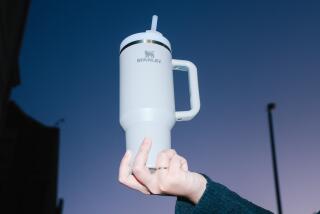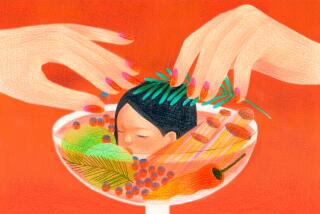Cola by Any Other Name Still Sweet But Sells Better
- Share via
Daylan Hamilton admits it: He occasionally chugs down a Pepsi. This, of course, runs contrary to his corporate fitness major at Colorado State University in Ft. Collins, Colo.
While at the supermarket recently, however, Hamilton shuffled by the regular Pepsi and snatched a few six-packs of Crystal Pepsi--a clear cola with less sugar that looks like sparkling water. “It’s basically good for you,” he said, “but it still has Pepsi taste.”
Pepsi’s marketing wizards couldn’t have said it better. In fact, that is precisely the message that Pepsi is spending millions of dollars to communicate in a handful of test-market cities selling the transparent cola.
It is modeled after other “New Age” soft drinks, such as Clearly Canadian and Sundance, that claim to be all-natural and lower in sodium. The basic marketing strategy behind Crystal Pepsi: If it looks healthy, it must be healthy.
Meanwhile, Coca-Cola also has a drink in test-marketing that it calls Coke II. That might sound like some sort of big-screen sequel to the real thing, but it’s not. It is actually the failed formula of “New Coke” repackaged--and re-christened.
Clearly, these days in soft drink marketing, seeing is not believing. In search of any new consumer niche, Pepsi is basically removing color--and some sugar--from its cola, while Coke is simply repackaging an existing product.
(Executives at Coke and Pepsi won’t say when their new products will be sold in Southern California, but industry analysts expect both to be on store shelves by midsummer.)
After decades of growth, the $48-billion soft drink industry is actually losing business. Sales that annually grew from 4% to 6% in the 1980s have dropped dismally in the 1990s. Sales were generally flat in 1991--and some major brand names saw declines.
Some consumers are turning to healthier sport drinks, such as Gatorade, and others are trying to save money by drinking less-expensive packaged drink mixtures. While both Coke and Pepsi have recently invested in these areas, they are desperately trying to hang on to their core cola customers with marketing hocus-pocus that experts say may backfire.
“People are looking for sincerity these days, whether it’s in Ross Perot or plain old Pepsi,” said Michael Solomon, marketing professor at Rutgers University. “Eventually, consumers will throw up their hands and say: Just give us the regular stuff.”
But don’t expect the cola giants to listen. “These companies just want to increase their market, whatever it might take,” said Virginia Johnson, manager of the Safeway store in Ft. Collins. “The games they play to get more customers are amazing--like getting people to think they have something new and different.”
More to the point, said Tom Pirko, president of the Los Angeles-based consulting firm Bevmark, “They must find ways to grow their business to keep stockholders happy.”
Coke II is new only in name. Sales of New Coke steadily declined after it was introduced in 1985--until its market share nationally slipped below 1%. But two years ago in Spokane, Wash., Coca-Cola gave a new name and new package to its slow-selling, sweeter-tasting cola, and since then its sales have nearly doubled in Spokane, spokesman Randy Donaldson said.
“The beverage business these days is all about options. When you see a chance to build volume, it’s crazy not to,” he said. “Besides, we found that people are willing to try something new.”
Indeed, when a company with an established product puts a “new and improved’ sign on it, people will buy it--at least once, said Gerald Jellison, professor of psychology at USC. “We’re all suspicious of new things, but we’re also curious,” he said.
Executives of Pepsi and Coke hope that curiosity translates into something more than a one-time purchase of their new drinks. That’s why Pepsi says it undertook such extensive product testing. Over a 15-month period, it created nearly 3,000 taste variations before finally settling on one. And it considered--and rejected--dozens of names for the newfangled product. Among them: Pepsi Clear and Pepsi Ice.
“It is a product based entirely upon consumer needs,” said Brian Swette, senior vice president of new beverages at Pepsi.
Do consumers need a colorless cola? Just in case some don’t, Pepsi has been running special price promotions on Crystal Pepsi in three test-market states: Colorado, Texas and Rhode Island. Over Memorial Day weekend, one grocery chain in Providence, R.I., was practically giving away two-liter bottles of Crystal Pepsi--charging a paltry 39 cents (with coupons) instead of the usual $1.49.
“It’s blowing off the shelves,” said a clerk at an Almacs grocery store in Cranston, R.I. The new drink is also selling well at an Albertson’s supermarket in Dallas. But the store manager believes that the fad will fade. “It’s just a novelty,” he said. “People are trained to drink a brown cola, and that’s what they’ll eventually want.”
That is basically what student Daylan Hamilton discovered when he started talking with his college friends about Crystal Pepsi. “Some of them don’t think it tastes like Pepsi at all,” he said. “They think it tastes like 7-Up.”
Briefly . . .
This week, the California Lottery is expected to award its $25-million ad business to one of four West Coast agencies. . . . Vogel Communications of Los Angeles has won the estimated $500,000 ad business for AOM French Airlines. . . . Haagen-Dazs Co. has hired BDS Marketing of Irvine to oversee West Coast product sampling of its frozen yogurt. . . . Los Angeles-based Adtech Marketing Inc. has won the $300,000 ad business for Santa Monica-based Retix’s new computer networking system. . . . The San Juan Capistrano ad agency Lupo & Associates has won the ad business for Costa Mesa-based Maxell Winches, maker of boat winches. . . . The Lusion Creative Agency of Los Angeles has been formed by former Max Factor creative directors Jasun Martz and Terri Hopper. . . . “Marketing’s Seven Deadly Sins” is the topic of Thursday’s meeting of the Direct Marketing Club of Southern California at 5:30 p.m. at the Marriott Hotel in Marina del Rey.
Soft Drinks Struggle for Stamina While Coke and Pepsi remain the kingpins of soft-drink sales, they are losing some clout. Pepsi-Cola actually lost market share domestically in 1991 and Classic Coke sales were virtually flat. To win new customers, Coke and Pepsi are test-marketing new products. Percent of Soft-Drink Market Dr. Pepper: 5% Diet Pepsi: 6.2% Diet Coke: 9.2% Pepsi-Cola: 16.6% Classic Coke: 19.5% Others: 43.5% Source: Beverage Industry, Wheat First Butcher & Singer.
More to Read
Eat your way across L.A.
Get our weekly Tasting Notes newsletter for reviews, news and more.
You may occasionally receive promotional content from the Los Angeles Times.









